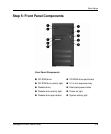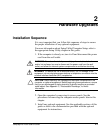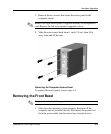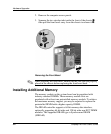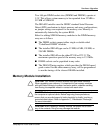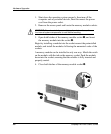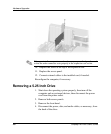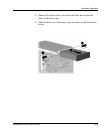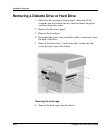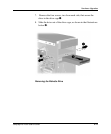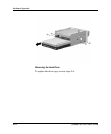
Hardware Upgrades
Two 168-pin DIMM socket sites (DIMM0 and DIMM1) operate at
3.3V. This allows system memory to be expanded from 32 MB to
512 MB of SDRAM.
The DRAM Controller uses the JEDEC standard Serial Presence
Detect (SPD) mechanism to detect memory and array configurations;
no jumper settings are required for the memory size. Memory is
automatically detected by the system BIOS.
Rules for adding SDRAM memory modules to the DIMM memory
array are as follows:
■
The DIMM sockets support either single or double-sided
“Unbuffered DIMM” modules.
■
The installed DRAM type can be 32 MB, 64 MB, 128 MB, or
256 MB DIMMs.
■
The installed DRAM can be either PC100 or PC133. The
maximum operation speed of the memory array is 133 MHz.
■
DIMM sockets can be populated in any order.
■
The DRAM Timing register, which provides the DRAM speed
grade control for the entire memory array, will be programmed
to use the timings of the slowest DRAMs installed.
Memory Module Installation
CAUTION: Your memory module sockets have gold metal contacts.
When upgrading your memory, it is important to use memory modules
with gold metal contacts to prevent corrosion and/or oxidation resulting
from having incompatible metals in contact with each other.
CAUTION: Static electricity can damage the electronic components of
the computer or optional cards. Before beginning these procedures,
ensure that you are discharged of static electricity by briefly touching a
grounded metal object. Refer to Appendix C, “Electrostatic Discharge,”
for more information.
CAUTION: When handling a memory module, be careful not to touch
any of the contacts. Doing so may damage the module.
Compaq Evo D300 User’s Guide 2-5





